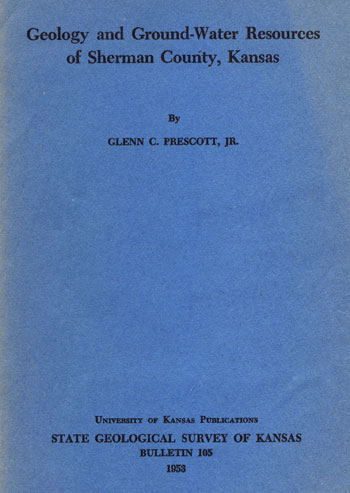Geology and Ground-water Resources of Sherman County, Kansas
By Glenn C. Prescott, Jr.

Originally published in 1953 as Kansas Geological Survey Bulletin 105. This is, in general, the original text as published. The information has not been updated.
You may also wish to visit our web site on the Sherman County geologic map.
Abstract
This report describes the geography, geology, and ground-water resources of Sherman County in northwestern Kansas. The county has an area of 1,055 square miles and in 1950 had a population of 7,373. Sherman County lies entirely within the High Plains section of the Great Plains physiographic province and consists of nearly flat to gently rolling upland plains dissected in several areas by relatively shallow valleys. The climate is semiarid, the average annual precipitation being about 18 inches. Farming and livestock raising are the principal occupations in the area. A small amount of irrigation is practiced in the county.
The outcropping rocks in Sherman County are sedimentary, ranging in age from late Cretaceous to Recent. Most of the county is underlain by deposits of Tertiary Ogallala formation, which in most places is covered by wind-blown silts of the Sanborn formation of Pleistocene age. The Pierre shale of late Cretaceous age has been exposed by erosion in a few localities in southern Sherman County. Deposits of Recent alluvium are along most of the stream valleys. The report contains a map showing the areal distribution of outcropping rocks; subsurface relations are shown in cross sections.
The Ogallala formation is the principal water-bearing formation in Sherman County, and in places large yields can be obtained from wells in permeable water-bearing beds in this formation. Alluvial deposits along parts of Beaver Creek and the North Fork Smoky Hill River yield water to wells in places where the deposits are below the water table.
The report contains a map of the county showing the locations of wells for which records were obtained and showing by means of shading the depths to water level. The water table ranges in depth from less than 10 feet in some stream valleys to more than 200 feet in one area in the southeastern part of the county. The depth to water level in most of the upland areas is more than 100 feet. Included in the report is a contour map showing the shape and slope of the water table. This map indicates that ground water moves in a general easterly or northeasterly direction; the average slope of the water table is about 15 feet per mile.
The ground-water reservoir is recharged principally by ground-water flow that enters Sherman County from the west and southwest and to a less extent by precipitation that falls within the area. Ground water is discharged by transpiration or evaporation, by springs, by seepage into streams, by subsurface movement into adjacent areas to the east, and by wells. Most of the domestic, stock, public, and irrigation supplies are obtained from wells.
Irrigation is not practiced extensively in Sherman County. With the exception of the southeastern part, much of the county is underlain by a considerable thickness of water-bearing beds. Depths to water are generally relatively great and permeabilities of water-bearing beds are generally low. Some beds in the Ogallala are rather permeable, however, and moderately large yields can be obtained from wells penetrating these beds. That irrigation may increase in the future is probable; the most favorable area for future irrigation is along parts of Beaver Creek.
Analyses of 24 samples of ground water are given, together with a discussion of principal chemical constituents in relation to use. Analyses indicate that water from Ogallala and alluvial deposits is moderately hard, but is suitable for most purposes. Water from the Pierre shale contains a slightly higher concentration of dissolved solids than water from the Ogallala or alluvium. The field data upon which this report is based are given in tables; they include records of 326 wells, chemical analyses of 24 water samples from selected wells, and logs of 41 wells and test holes, including 29 test holes drilled as part of this investigation and 2 test holes drilled on the Sherman-Thomas County line as part of an investigation of the geology and groundwater resources of Thomas County.
Kansas Geological Survey, Geology
Placed on web Aug. 1, 2008; originally published Nov. 1953.
Comments to webadmin@kgs.ku.edu
The URL for this page is http://www.kgs.ku.edu/General/Geology/Sherman/index.html